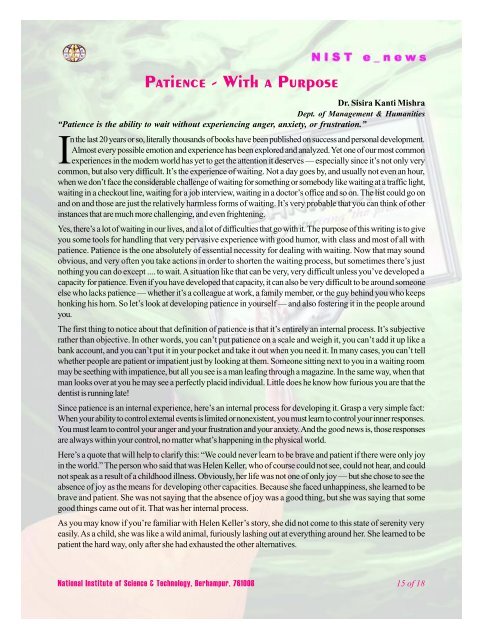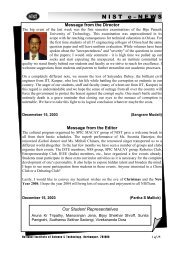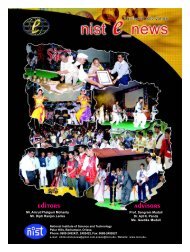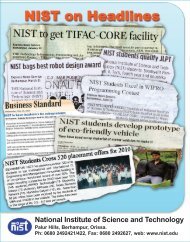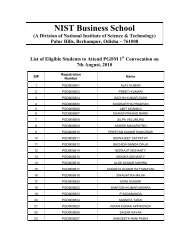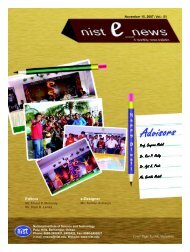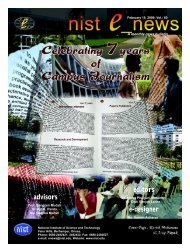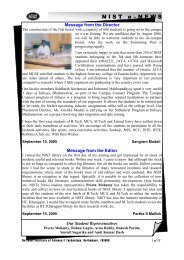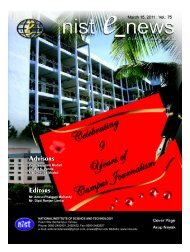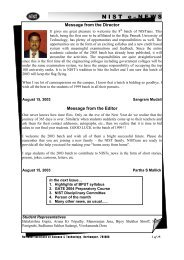NIST e-NEWS(Vol 56, Sept 15, 2008)
NIST e-NEWS(Vol 56, Sept 15, 2008)
NIST e-NEWS(Vol 56, Sept 15, 2008)
- No tags were found...
You also want an ePaper? Increase the reach of your titles
YUMPU automatically turns print PDFs into web optimized ePapers that Google loves.
Patience - With a PurposeDr. Sisira Kanti MishraDept. of Management & Humanities“Patience is the ability to wait without experiencing anger, anxiety, or frustration.”In the last 20 years or so, literally thousands of books have been published on success and personal development.Almost every possible emotion and experience has been explored and analyzed. Yet one of our most commonexperiences in the modern world has yet to get the attention it deserves — especially since it’s not only verycommon, but also very difficult. It’s the experience of waiting. Not a day goes by, and usually not even an hour,when we don’t face the considerable challenge of waiting for something or somebody like waiting at a traffic light,waiting in a checkout line, waiting for a job interview, waiting in a doctor’s office and so on. The list could go onand on and those are just the relatively harmless forms of waiting. It’s very probable that you can think of otherinstances that are much more challenging, and even frightening.Yes, there’s a lot of waiting in our lives, and a lot of difficulties that go with it. The purpose of this writing is to giveyou some tools for handling that very pervasive experience with good humor, with class and most of all withpatience. Patience is the one absolutely of essential necessity for dealing with waiting. Now that may soundobvious, and very often you take actions in order to shorten the waiting process, but sometimes there’s justnothing you can do except .... to wait. A situation like that can be very, very difficult unless you’ve developed acapacity for patience. Even if you have developed that capacity, it can also be very difficult to be around someoneelse who lacks patience — whether it’s a colleague at work, a family member, or the guy behind you who keepshonking his horn. So let’s look at developing patience in yourself — and also fostering it in the people aroundyou.The first thing to notice about that definition of patience is that it’s entirely an internal process. It’s subjectiverather than objective. In other words, you can’t put patience on a scale and weigh it, you can’t add it up like abank account, and you can’t put it in your pocket and take it out when you need it. In many cases, you can’t tellwhether people are patient or impatient just by looking at them. Someone sitting next to you in a waiting roommay be seething with impatience, but all you see is a man leafing through a magazine. In the same way, when thatman looks over at you he may see a perfectly placid individual. Little does he know how furious you are that thedentist is running late!Since patience is an internal experience, here’s an internal process for developing it. Grasp a very simple fact:When your ability to control external events is limited or nonexistent, you must learn to control your inner responses.You must learn to control your anger and your frustration and your anxiety. And the good news is, those responsesare always within your control, no matter what’s happening in the physical world.Here’s a quote that will help to clarify this: “We could never learn to be brave and patient if there were only joyin the world.” The person who said that was Helen Keller, who of course could not see, could not hear, and couldnot speak as a result of a childhood illness. Obviously, her life was not one of only joy — but she chose to see theabsence of joy as the means for developing other capacities. Because she faced unhappiness, she learned to bebrave and patient. She was not saying that the absence of joy was a good thing, but she was saying that somegood things came out of it. That was her internal process.As you may know if you’re familiar with Helen Keller’s story, she did not come to this state of serenity veryeasily. As a child, she was like a wild animal, furiously lashing out at everything around her. She learned to bepatient the hard way, only after she had exhausted the other alternatives.National Institute of Science & Technology, Berhampur, 761008 <strong>15</strong> of 18


